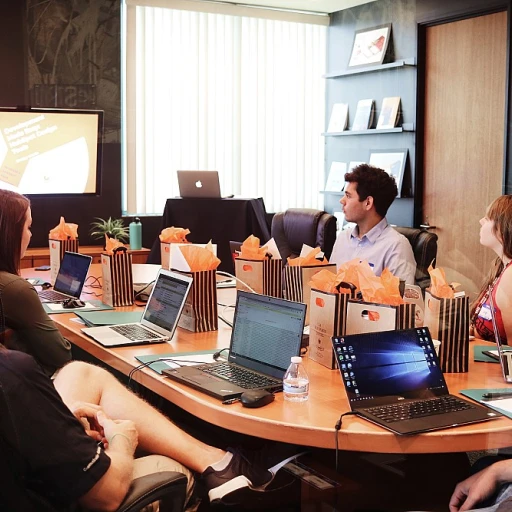
Understanding On-the-Job Learning
Embracing the Context of On-the-Job Learning
On-the-job learning has ensured its place in the modern workplace, largely due to its immersive nature. Unlike traditional learning environments where classes and training programs may involve lectures in isolation, this approach ingrains learning directly within the work setting. Here, employees learn blueprints of their future tasks on-site, which can arguably lead to more profound expertise and skill acquisition. One of the crucial aspects of on-the-job learning is its focus on real-world application. This method offers employees both the luxury and the challenge of grasping skills first-hand in their job. It aids in preparing individuals for a full-time career advancement by providing them with actual responsibilities that contribute to the company's objectives. Encouraging departments to incorporate a robust training program allows employees to enhance their skill sets efficiently. The tangible impact of these experiences pushes employees to not only learn skills applicable to their current roles but also those valuable for future opportunities, making them versatile assets in any industry. Incorporating these strategies directly into career development initiatives can significantly benefit both the company and employees. To effectively harness the potential of on-the-job training, it's essential to identify the correct balance of structured guidance and hands-on experience. A balanced training program can propel employees toward a successful career trajectory by offering opportunities to refine their expertise and adapt to evolving business needs. For more insights on crafting impactful learning experiences at work, you can explore the effective instructional design portfolio, which delves deeper into creating engaging and successful on-the-job training frameworks.The Benefits of Learning While Working
Learning While Gaining Experience
Learning while working provides a unique set of benefits that traditional classroom education often cannot offer. On-the-job experiences allow employees to acquire and refine their skills in a practical, hands-on environment. This approach integrates training within the daily job functions, thus enabling workers to learn as they perform their tasks, leading to a seamless blend of career growth and productivity.
A key advantage of on-the-job learning is the opportunity for employees to engage with real-world challenges in their field. Rather than theoretical exercises, the learning happens through direct involvement in the work processes. Employees thus gain practical insights and a deeper understanding of their role within the company, which often accelerates their personal and professional development.
In addition, on-the-job training programs provide employees with the adaptability required in a rapidly changing work environment. As industries evolve, so do the skills needed to remain competitive. These programs offer the flexibility to learn and adapt to new technologies and methodologies as they are introduced. Workplace training opportunities therefore play a crucial role in equipping individuals with the dynamic skills necessary to overcome the intricacies of modern job demands.
Moreover, the social aspect of learning at work should not be underestimated. Interacting with colleagues and participating in collaborative projects can help enhance social learning. Employees can share knowledge and experiences, facilitating a collective growth in expertise and understanding.
For people with disabilities and those re-entering the job market, on-the-job training offers a supportive platform for skill acquisition and career development. The services provided by these programs can be more accommodating, offering tailored training resources that help people overcome specific challenges they face.
To learn more about how innovative assessment methods can enhance the efficacy of reskilling programs, you might find this exploring innovative assessment methods for reskilling insightful.
Challenges in On-the-Job Reskilling
Overcoming Hurdles in Career Growth
Reskilling in the form of on-the-job learning offers abundant opportunities to bolster one’s skill set, yet it comes with its own set of challenges. The very nature of learning while working poses unique difficulties that both companies and employees must navigate to achieve successful career development. One significant challenge is managing time effectively. For instance, individuals balancing full-time job responsibilities alongside a demanding training program often struggle to find enough hours in the day to accommodate both work and learning. Without adequate planning, employees may feel overwhelmed by the task of integrating training opportunities into their daily schedules. Moreover, employees with disabilities face distinct challenges. They may require specialized training resources or adaptive services provided to ensure they can fully participate in reskilling programs. Offering accessible job training and learning programs is crucial, allowing every individual the ability to enhance their skills effectively. Companies also wrestle with maintaining a balance between productivity and learning. While training helps employees learn valuable new skills, businesses must provide learning opportunities that do not detract from the company’s performance. Therefore, businesses need to integrate hands-on experience with regular work duties to ensure that employees can synthesize new knowledge in an applied setting. To help people overcome these hurdles, it is important to provide supportive social learning environments. Programs that foster group activities can facilitate a shared learning experience that amplifies problem-solving and innovation. Also, providing training job tasks aligned with employees’ career aspirations can boost their motivation and commitment to the training. Navigating these hurdles requires a strategic approach focused on adaptable, employee-centric solutions. This often means tailoring services provided and training programs to meet the distinct needs and career goals of individuals, ultimately leading to more successful outcomes in workforce development. For further insights on overcoming these challenges, the article Mastering Skills Through On-the-Job Learning explores practical strategies that can help enhance your navigational skills in a dynamic work setting.Strategies for Effective On-the-Job Learning
Leveraging Resources for Effective Skill Development
Engaging in on-the-job learning can be an enriching way to boost one's career, but to maximize the benefits, it's essential to have strategies in place. The importance of structured approaches cannot be overstated, as they provide a roadmap for both employees and the companies they work for. One of the crucial steps in mastering skills through workplace learning involves identifying the right training opportunities. Companies often offer specialized training programs to help employees develop the skills needed for their roles. By taking advantage of these programs, employees can gain hands-on experience and learn job-specific tasks more efficiently. Job training is not just about attending classes; it's also about integrating new skills into your everyday work. Social learning is another powerful strategy. Encouraging employees to learn from their peers and colleagues can foster a collaborative work environment. Social learning happens through observation or informal exchanges, significantly enhancing the training job experience. Creating a culture of learning within the workplace also helps minimize the challenges commonly faced in the journey of skill mastery. Employers providing training resources play a pivotal role in career development. By offering a variety of programs that cater to different learning styles and needs, businesses ensure that their staff find the right fit. Programs offered can range from full-time classes to on-the-job training sessions. Additionally, services provided often cater to individual employee needs, ensuring inclusive growth opportunities, including those for people with disabilities. Accommodating personalized training plans is crucial in addressing diverse learning preferences. It's vital for companies to offer flexibility in their training programs, allowing employees to integrate learning into their existing work schedules effectively. Delivering tailored learning experiences can facilitate smoother transitions and lead to more productive outcomes. Organizations also benefit from aligning with external bodies like the department of labor, which can offer insights into industry trends and provide access to further training resources. This partnership can bolster a company's capacity to assist employees in their job search by equipping them with market-relevant skills. Ultimately, combing these strategies ensures that training programs are not just about checking the box but are a significant step towards a more skilled and confident workforce. It prepares employees for future roles, positions the company as forward-thinking, and strengthens its position in a competitive market.Case Studies of Successful On-the-Job Reskilling
Real-World Examples of Workplace Learnings
Understanding how on-the-job learning can be successfully implemented is best showcased through real-world cases. Several companies have led the way in integrating effective on-the-job training programs that highlight the value of learning by doing. Consider a company in the construction industry that established a robust program designed to help employees acquire new skills directly in the field. This organization's focus was to provide hands-on experience, coupled with mentorship from experienced workers, as employees tackled tasks during work hours. This approach not only allowed employees to refine their practical abilities but also fostered a culture of continuous learning. Similarly, financial institutions have rolled out tailored training initiatives aimed at skill acquisition while simultaneously performing job responsibilities. These programs offered employees the chance to specialize in new areas, such as cybersecurity or data analysis, without needing to leave their current roles. By leveraging services provided in-house, employees were able to transition into new positions seamlessly, thereby advancing their careers while benefiting the company. Another noteworthy example comes from the healthcare sector, where a training team developed a comprehensive program that enabled medical professionals to learn job skills while treating patients. This initiative proved invaluable not only for individuals but also for the institution as it ensured that the latest medical practices were being utilized.Innovative Training Services Empower Diverse Workforces
Many organizations have embraced inclusivity within their training programs, offering training opportunities and resources for people with disabilities or those seeking to re-enter the workforce. Collaborations with departments of labor and specialized services aimed at creating accessible training environments have been instrumental. Some programs offer part-time job training which accommodates employees' unique schedules and capabilities, ensuring that everyone has a chance to thrive. Social learning has also emerged as a powerful tool, where employees learn from each other, exchanging ideas and strategies in real time. By integrating various digital platforms, companies have nurtured a culture of shared knowledge across different levels of employment. These programs have allowed employees to connect and explore innovative solutions, promoting a more collaborative workforce. The emphasis on employee-driven learning initiatives has also allowed people to take ownership of their career development paths. Employees are encouraged to explore training classes that align with their interests and career aspirations, maximizing the efficacy of their personal learning journey. As these examples show, the impact of effective on-the-job learning strategies is multi-faceted, providing advantages to the company, employees, and broader industry. By continuing to innovate and offer diverse training programs, businesses can be better positioned to adapt to future trends and challenges.Future Trends in Workplace Learning
Emerging Trends in Workplace Learning
The landscape of workplace learning is rapidly evolving, driven by technological advancements and shifting workforce needs. As companies strive to remain competitive, they are increasingly investing in innovative training programs that align with future demands.
Integration of Technology in Training Programs
Technology is playing a pivotal role in reshaping how employees learn skills on the job. From virtual reality simulations to AI-driven personalized learning paths, companies are leveraging these tools to provide hands-on experience without the constraints of traditional classroom settings. This approach not only enhances the learning experience but also allows employees to learn at their own pace, making it more adaptable to individual needs.
Focus on Soft Skills and Social Learning
While technical skills remain crucial, there is a growing emphasis on soft skills such as communication, teamwork, and problem-solving. Training programs are increasingly incorporating social learning elements, where employees learn from each other through collaboration and shared experiences. This method not only helps in skill acquisition but also fosters a more cohesive work environment.
Customized Learning Paths and Career Development
Personalization is becoming a key component of effective training programs. Companies are offering tailored learning paths that align with individual career development goals. By doing so, they help employees find the right training opportunities that match their career aspirations, ultimately leading to higher job satisfaction and retention rates.
Support for Diverse Workforce Needs
Recognizing the diverse needs of the workforce, companies are designing training programs that cater to people with disabilities and those seeking flexible learning options. This inclusive approach ensures that all employees have access to the resources they need to succeed in their roles.
Collaboration with External Training Providers
Many organizations are partnering with external training providers to enhance their reskilling efforts. These collaborations bring in fresh perspectives and expertise, offering employees a broader range of skills and knowledge. By tapping into external resources, companies can provide comprehensive training programs that address both current and future skill requirements.
As these trends continue to shape the future of workplace learning, it's clear that companies must remain agile and proactive in their approach to employee development. By embracing these changes, they can ensure their workforce is equipped with the skills needed to thrive in an ever-evolving job market.













